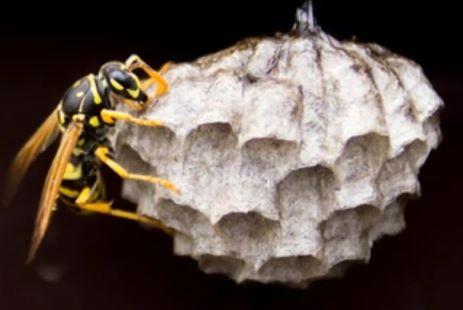Wasp advice
About Wasps
The common wasp has yellow and black markings, their nests are white to grey, round and paper like with an entrance hole at the base.

In the earlier stages the wasp nest is usually the size of a ping pong ball, however they can grow large enough to accommodate over 20,000 workers. Whilst wasps can be beneficial by preying on other insect pests, they are most known for their painful sting which, unlike a bee’s sting, can be used repeatedly.
Finding Wasps
New nests start to be built in late spring and will be abandoned by late summer/autumn. Nests can be found in roof spaces, eaves, air vents, trees and bushes and even in the ground. Wasps are more active during the day and during the summer months when the workers will forage for sweet tasting food sources.
Information on being stung
For most people being stung by a wasp results in a sharp pain and a localized swelling around the sting, however a very small number of people can suffer a severe allergic reaction (anaphylactic shock).
If you are stung by an insect then you must ensure that the wound does not get infected, by cleaning it with an antiseptic wash or soap and water as soon as possible. Placing a flannel or cloth soaked in cold water over the wound will help reduce any swelling. Avoid scratching the affected area to reduce the risk of infection. If there is a lot of swelling/blistering or there is pus in the wound this may indicate the wound has become infected. In that event you are advised to consult your local doctor.
If you experience any of the following symptoms as a result of a bite/sting then you are advised to call 999 and ask for an ambulance;
- wheezing or difficulty breathing
- nausea, vomiting or diarrhoea
- A fast heart rate
- dizziness or feeling faint
- difficulty swallowing
- confusion, anxiety or agitation
For further details visit the NHS website.
How do I treat wasps?
Due to the risks involved it is advisable to hire a professional pest contractor to treat for wasps.
Wasps will become extremely agitated when sprayed with insecticide, which can take a few hours to take effect and a few days to kill the whole nest, during which time the wasps will likely attack all perceived threats in the immediate vicinity. The risks are increased when treating in confined spaces (i.e. lofts) or at height (i.e. under eaves).
When using do-it-yourself treatments always read the instructions fully before treating. The best time to treat is early or late in the day when the wasps will be the least active. Wear suitable protective clothing (ideally a beekeepers suit although garden gloves and overalls are preferable to regular clothes) to reduce the risk of being stung, ensure that you can get a safe distance away from the treated nest as quickly and safely as possible, and where appropriate advise your neighbours, visitors etc. of the treatment should they be put at risk (i.e. nest treated in a garden hedge etc.). Be careful of carrying out treatments within enclosed spaces such as lofts where you may not be able to leave quickly and safely once a treatment has been applied.

